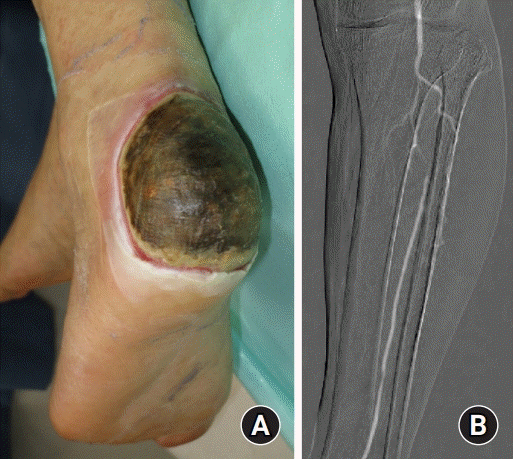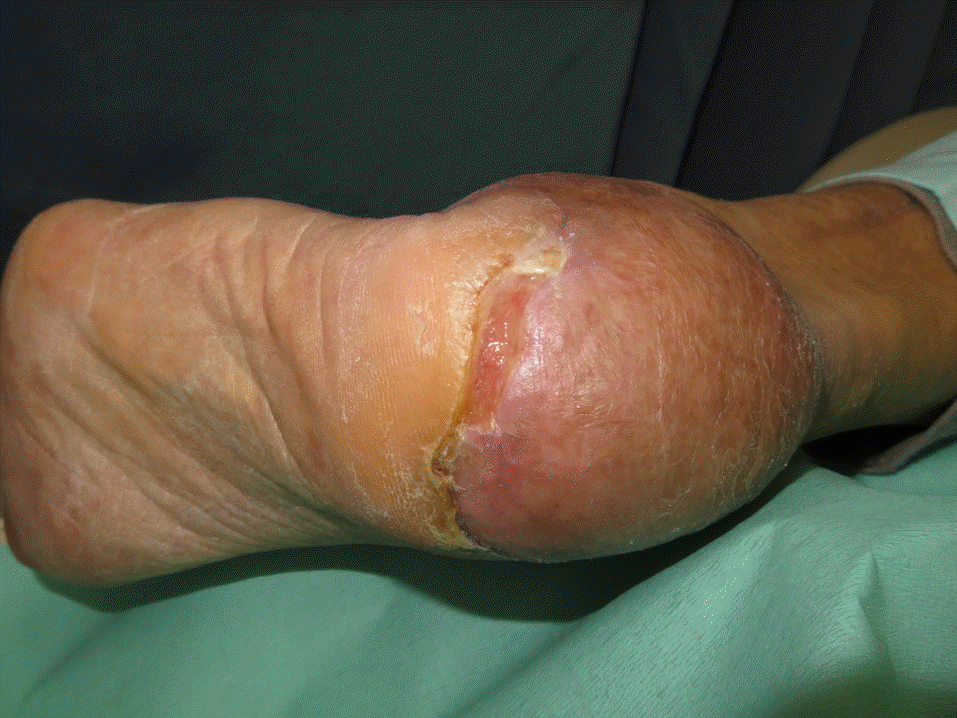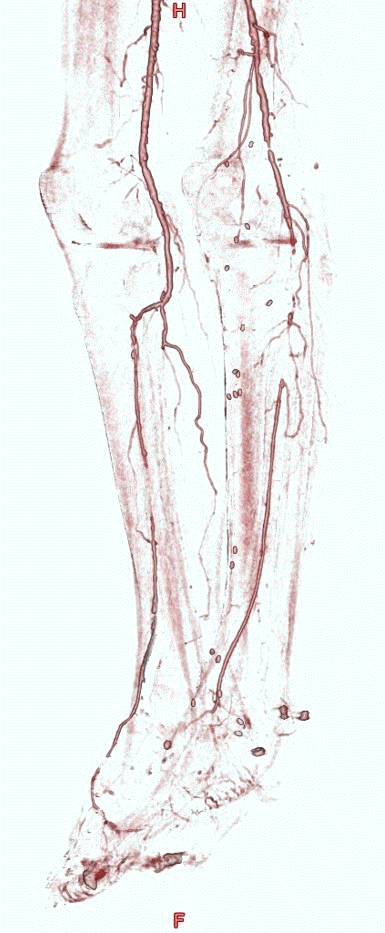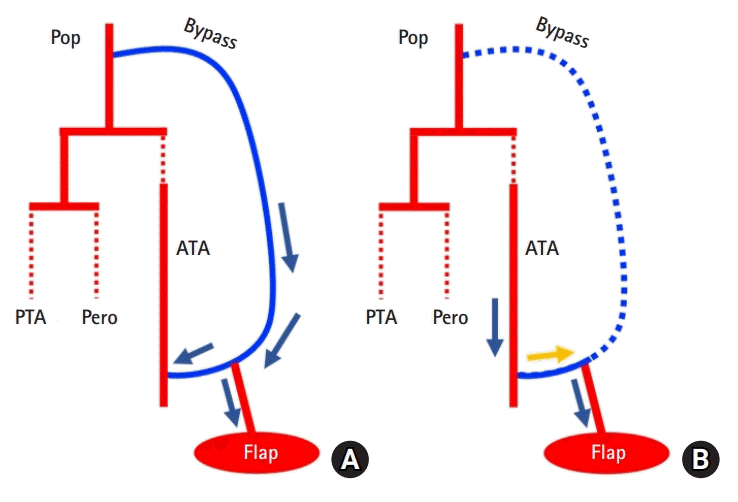Abstract
Distal bypass combined with a free flap is a frequent surgical option for ischemic ulcers of the lower extremities. Here, we describe a patient in whom there was a change in the direction of blood flow in a distal bypass graft. A 68-year-old male patient with an ischemic ulcer on his left heel was referred to our facility by a local dermatology clinic. Surgical revascularization was performed between the popliteal artery and the dorsalis pedis artery using an ipsilateral great saphenous vein as the graft vessel. The wound site did not heal postoperatively, so it was covered using a free latissimus dorsi muscle flap. At the same time, the thoracodorsal artery was anastomosed to the bypass graft in an end-to-side manner to serve as a nutrient vessel. Initially, blood flow into the thoracodorsal artery from the bypass graft was via the popliteal artery. However, after occlusion of the proximal anastomotic site of the bypass graft, blood flow into the thoracodorsal artery from the bypass graft was via the dorsalis pedis artery, which was the distal anastomotic site. The change in direction of blood flow might have been the result of an increase in blood flow in the collateral vessels in the ischemic lower leg, which eventually overwhelmed the blood flow in the bypass graft.
Revascularization is the best option for limb salvage in patients with critical limb ischemia [1]. However, intermittent pneumatic compression, spinal cord stimulation, and exercise therapy can be used to increase distal perfusion in patients who are not candidates for surgical or endovascular intervention [2]. Although these therapies are known to increase blood flow in an ischemic limb, any hemodynamic changes that occur after treatment are difficult to detect. We encountered a patient in which a change in direction of blood flow in a grafted vessel was likely caused by the flow in the bypass graft becoming overwhelmed by increased perfusion in the remaining native collateral vessels.
A 68-year-old male patient with congestive heart failure, chronic kidney disease (not hemodialysis-dependent), type 2 diabetes, hypertension, and dyslipidemia was referred to our facility by a local dermatology clinic with dry necrosis of the left heel (Fig. 1A). Physical examination suggested limb ischemia. Angiography revealed occlusion of the anterior tibial artery, posterior tibial artery, and fibular artery in the left leg (Fig. 1B). Surgical revascularization was performed between the popliteal artery and the dorsalis pedis artery using the ipsilateral great saphenous vein. The proximal and distal anastomoses were sutured in an end-to-side manner. However, the wound did not heal. On day 53 after bypass surgery, the soft tissue defect on the heel was covered using a latissimus dorsi muscle flap. The thoracodorsal artery was selected as a nutrient vessel and anastomosed to the bypass graft in an end-to-side manner approximately 3 cm proximal to the site of the anastomosis between the bypass graft and the dorsalis pedis artery. The collateral vein accompanying the thoracodorsal artery was anastomosed to the collateral vein accompanying the dorsalis pedis artery. However, the pulse in the bypass graft was lost on day 16 after the free flap transfer. Angiography at this time revealed that the site of the proximal anastomosis was occluded. The occluded vessel was successfully revascularized by endovascular therapy and the latissimus dorsi flap survived. On day 43 after the free flap transfer, the patient was moved to a rehabilitation facility. Since then, the patency of the bypass graft and the thoracodorsal artery has been monitored regularly by ultrasonography in the outpatient department. The pulse in the bypass graft was lost again on day 124 after the free flap transfer. Endovascular revascularization was attempted but failed on day 128. On day 240 after the free flap transfer, the patient remains ambulatory and the muscle flap continues to be viable (Fig. 2). Computed tomography angiography on day 331 revealed a less obvious pedicle but a still viable flap (Fig. 3). Some collateral vessels to the native anterior tibial artery were apparent.
Combined distal bypass and free flap transfer for salvage of critical limb ischemia have favorable results [3]. The concept of a nutrient flap delivering and increasing perfusion in an ischemic area was first proposed over 30 years ago [4]. Evidence of a new capillary connection being established between the nutrient flap and the ischemic region was provided more recently by Tanaka et al. [5]. By nourishing the ischemic limb, local conditions are improved enough to allow the free flap to survive, even when the pedicle is occluded [6].
In this case, although surgical revascularization was successful in terms of restoring perfusion of the ischemic limb, the status of the wound did not improve. Therefore, a latissimus dorsi free flap transfer was performed to both cover the defect and nourish the wound area. Sixteen days later, the pulse in the bypass graft was lost. Angiography at this time showed that the blood flow to the free flap was passing through the native anterior tibial artery, the distal end of the bypass, and into the thoracodorsal artery (Fig. 4). Therefore, there was a change in the direction of blood flow in the distal portion of the bypass graft (Fig. 5). Thereafter, perfusion of the bypass graft and thoracodorsal artery was monitored using ultrasonography. Blood flow in the bypass graft decreased gradually week by week and ceased completely on day 124 after the free flap transfer. However, the free flap has survived and the patient remains ambulatory. We believe that perfusion via the collateral vessels accompanying the anterior tibial artery increased as a result of improvement in limb function, including weight bearing and ambulation, to the point that it overwhelmed blood flow via the bypass graft. Unlike the graft vessel whose branches were ligated and nerves denervated, the native artery has smaller branches with the potential to increase the flow.
To our knowledge, this is the first report of a change in direction of blood flow in a bypass graft with angiographic evidence. Further research on the potential for this issue to occur in the ischemic limb is needed.
References
1. Mätzke S, Tukiainen EJ, Lepäntalo MJ. Survival of a microvascular muscle flap despite the late occlusion of the inflow artery in a neuroischaemic diabetic foot. Scand J Plast Reconstr Surg Hand Surg. 1997; 31:71–5.

2. Tanaka K, Igari K, Kishino M, et al. The possibility of free tissue transfer as a nutrient flap for critical ischemic foot: a case report. Microsurgery. 2017; 37:694–8.

3. Meyer A, Goller K, Horch RE, et al. Results of combined vascular reconstruction and free flap transfer for limb salvage in patients with critical limb ischemia. J Vasc Surg. 2015; 61:1239–48.

4. Mimoun M, Hilligot P, Baux S. The nutrient flap: a new concept of the role of the flap and application to the salvage of arteriosclerotic lower limbs. Plast Reconstr Surg. 1989; 84:458–67.
Fig. 1.
(A) The heel is necrosed and the dry necrosis indicates leg ischemia. (B) Angiography using carbon dioxide gas reveals occlusion of three vessels below the knee.

Fig. 2.
Although the ulcer on the border of the flap and the original tissue remains present due to the continuous friction of the area, the muscle flap survives.

Fig. 3.
Computed tomography angiographic findings showing blood flow established through the collateral vessels to the left anterior tibial artery. Arrowheads indicate the native collateral artery and arrow indicates the thoracodorsal artery.

Fig. 4.
Angiographic findings reveal the loss of flow in the bypass graft. The thoracodorsal artery is patent thanks to the inflow perfusion from the bypass graft via the distal anastomosis site. Black arrowheads indicate the native anterior tibialis artery, arrow indicates the bypass graft, and white arrowheads indicate the thoracodorsal artery.

Fig. 5.
(A) Simplified scheme of the original blood circuit and (B) the scheme for days 16 and 240. Dark blue arrows indicate the original direction of the flow, orange arrow indicates changed direction of the flow, red lines indicate arteries, blue line indicates the bypass graft (originally the great saphenous vein), and dotted line indicates the occluded vessel. Pop, popliteal artery; ATA, anterior tibial artery; Pero, peroneal artery; PTA, posterior tibial artery.





 PDF
PDF Citation
Citation Print
Print



 XML Download
XML Download